#Ariel Parmigiani
Explore tagged Tumblr posts
Text

#separator#clear: both; text#integrante del Parque Arauco La Rioja#dio inicio a una nueva etapa en el proyecto de exploración de litio en el salar El Leoncito#en el Valle del Bermejo. Este proyecto impulsado en La Rioja con altos estándares ambientales y con un enfoque inclusivo y transparente ya#de los cuales 52 son ocupados por riojanos.<p></p><p>Al respecto#la secretaria de Minería de la provincia#Ivanna Guardia#destacó que “el inicio de esta nueva etapa de exploración de litio en El Leoncito marca un hito significativo en el desarrollo de minería s#que van a permitir obtener la factibilidad del proyecto#lo que es de gran relevancia para la Provincia teniendo en cuenta que es el proyecto más avanzado de litio en el territorio”.</p><p>En este#Guardia remarcó que “esto también tiene una relevancia en cuanto a la generación de puestos de trabajo#teniendo en cuenta que mientras los proyectos avanzan con resultados positivos#se incrementan las etapas de exploración lo que significa más mano de obra y también mano de obra calificada#por eso la gran tarea que tenemos nosotros como Estado es acompañar a los departamentos para especializar a la gente y que puedan cumplir c#características y los niveles que precisan las empresas mineras#dados los altos estándares que se deben cumplir tanto en la actividad como también en el cuidado ambiental”.</p><p>Sobre la oferta laboral#la secretaria de Minería señaló que “La Rioja tiene los profesionales para poder llevar adelante este tipo de proyectos#tenemos las universidades que hoy están formando a nuestros jóvenes técnicos#pero también necesitamos la mano de obra no calificada y otro tipo de proveedores#donde es la provincia quien debe acompañarlos para que se pueda desarrollar una nueva matriz productiva que genere más puesto de trabajo y#Ariel Parmigiani#presidente del Parque Arauco#destacó la importancia de este proyecto no solo para la empresa sino para la región y el país: “En 2021 y 2022#identificamos más de 20 salares y salinas con potencial de producción de litio. Nuestro compromiso con la minería sustentable es firme#cumpliendo con los más altos estándares de certificación de calidad ambiental” y subrayó#además#que este proyecto es parte de un esfuerzo más amplio para identificar y desarrollar recursos minerales estratégicos necesarios para combati#invitando a la comunidad a visitar el Salar El Leoncito y observar de primera mano las actividades de la empresa. “La idea es poder mostrar#o es turismo sí o minería no. Acá lo que vemos es minería
0 notes
Text
Se constituye Parque Eólico Arauco S.A.P.E.M. con un capital de $30 millones para impulsar la energía renovable en Argentina
La nueva sociedad, formalizada el pasado 8 de octubre, busca fortalecer el desarrollo de energías limpias en el país, abarcando desde la generación eléctrica hasta la consultoría en proyectos renovables. La sede se establece en Buenos Aires y el directorio está presidido por Ariel Darío Parmigiani. Parque Eólico Arauco S.A.P.E.M., con domicilio en la calle Buenos Aires 264 en La Rioja, fue…
0 notes
Text
Charla virtual Soberanía energética y productiva.
Charla virtual Soberanía energética y productiva.

Desde CTA Autónoma La Rioja invitamos a participar de un nuevo encuentro virtual donde hablaremos sobre los sectores e intereses en torno a la soberanía energética y tecnológica, con el Economista y actual titular de Parque Eólico, Ariel Parmigiani. Jueves 22 de Octubre A las 18 Hrs. Link de la sala: https://meet.google.com/mbs-jhyq-ewe
View On WordPress
0 notes
Text
Belgrano y un recuerdo único para el fútbol de Córdoba
Fue el último grito y el más fuerte de todo. El 20 de abril de 1986, Belgrano puso la primera estrella del fútbol cordobés en el ámbito de la AFA, en un torneo que nadie adivinaba qué rumbo podría tomar.
El Regional de 1986 es difícil de catalogar. No fue un torneo de ascenso, tampoco uno de la máxima categoría, porque faltaron los “picantes” de Buenos Aires.
Acaso la mejor definición sea aquella que habla de un torneo del interior paralelo al de Primera y que, en un principio otorgaría una plaza a la Copa Libertadores de América.
Su disputa ocurrió en pleno proceso de armar y desarmar en el que se había metido Julio Grondona y la dirigencia del interior del país, que por aquellos días ya retrocedía tras los efectos de división derivados de la Resolución 1.309, que dejó al movimiento federal sin tres pilares fuertes: los de Talleres, Instituto y Racing.
Así, aquel Campeonato Regional, cuya única edición se disputó en 1985/86, quedó inmerso en la transición hacia una reestructuración que modificó la participación de los clubes provincianos en AFA y en ese escenario complejo, este certamen terminó siendo tierra fértil para que el hincha le otorgue al mismo la interpretación antojadiza que mejor le quepa.
Para algunos, el torneo parece no haberse disputado jamás o no representó mucho más que un “simpático” certamen intrascendente.
Para otros, en cambio, se realizó para clasificar deportivamente a su campeón (Belgrano) a la primera edición del Nacional B. Y la verdad, que no puede “acomodarse” a la necesidad de ningún color, es otra muy distinta a estas dos versiones.
El Regional 1985/86 fue, ante todo, un campeonato oficial de AFA, lo que le permite a Belgrano presumir de ser el primer club cordobés en obtener un torneo en el ámbito nacional y, por si hacía falta alguna otra arista, en calidad de invicto.
Pero también es necesario aclarar que su consagración no le otorgó el pase al Nacional B, sino a la Liguilla Prelibertadores, una instancia a la que accedieron todos los semifinalistas de aquel certamen. En honor a la verdad, la participación del club en el panel estable del fútbol argentino se cristalizó, tal como ocurrió con Talleres, por medio de un acuerdo escrito.
Fue la Asociación Cordobesa de Fútbol la que dictaminó, en la madrugada del 12 de abril de 1986 y a través de la resolución 150, que los celestes sean los representantes de la plaza otorgada a la entidad madre del fútbol cordobés. Con aprobación unánime: la 150 fue conocida en el ámbito dirigencial de la época como “la 1.309 cordobesa”, en relación a la normativa que dispuso la inclusión de los albiazules a los torneos porteños, en 1980.
Hecha la salvedad histórica, el Regional ganado por Belgrano fue, quizás, el torneo más federal de la historia del fútbol argentino.
Y los datos son contundentes: participaron 106 clubes representativos de las 23 provincias del país, con 24 de ellos “veteranos” de los viejos nacionales de primera disputados entre 1967 y 1985. Estaban todos, sólo faltaron los tres clubes de la Docta acogidos en el fútbol porteño (Talleres, Instituto y Racing). Era, qué duda cabe, un auténtico campeonato provinciano, con los mejores representantes de cada rincón del país.
Su estructura única tuvo una razón de ser. Con la desaparición del Campeonato Nacional surgió la necesidad de otorgarles a los clubes de “tierra adentro” alguna motivación deportiva para que el Regional no sea sólo un “torneo paralelo” al porteño. Por ello, y hasta tanto se organizara el Nacional B, el mismo otorgaría plazas a la Liguilla Prelibertadores y tendría por primera vez a un campeón.
Un equipo récord
En aquellos años de transición, por capricho del destino o lo que sea, Belgrano contó con uno de los mejores equipos desde los ‘70. Los juveniles promovidos en el ’82 por “el Pucho” Arraigada ya habían madurado (Germán Martellotto, Julio Villagra, Edgardo Parmigiani y Ariel Ramonda), y a ellos se sumaron Abel Blasón, llegado de Lucas González (Entre Ríos), Luis Scatolaro (Chajarí), José Luis Villarreal (General Paz Juniors) y Juan José López (Argentinos Juniors), todos bajo las órdenes de Victorio Nicolás Cocco.
Belgrano, que en el nuevo contexto futbolístico se había quedado fuera de los grandes escenarios de la AFA, era para muchos el mejor equipo cordobés del momento.
En 1984 había sostenido un largo invicto de 39 partidos, hasta que Alumni de Villa María lo venció 2-1 en la antepenúltima fecha del Provincial, en un encuentro que terminó con incidentes dentro del plantel celeste y que determinó el alejamiento de Cocco.
Tras cartón, al año siguiente y con Tomás Cuellar como entrenador, se inició una nueva racha que se extendió a un cotejo más (40), y que se quebró ante Newell’s Old Boys (1-3) en el juego de ida de la Liguilla Prelibertadores.
Una máquinaLos equipos de Córdoba y Tucumán, habituales plazas fijas de los viejos nacionales, iniciaron el Regional en segunda fase. Y en su zona, Belgrano tuvo demasiadas dificultades para imponerse ante Unión San Vicente, un verdugo reiterado en los primeros años de los ’80 y, sobre todo, ante Belgrano de Paraná, que había conformado un plantel experimentado y de jerarquía, con el arquero Carlos Barisio (ex Ferro), el defensor Ricardo Fertonani (ex Colón), los volantes Juan Meglio (ex Instituto y Vélez) y Enrique Belloni (ex Platense) y el delantero Néstor Candedo (ex Huracán).
Y para ganar la zona, donde también participó el aguerrido Sportivo Norte de Rafaela, fue clave un heroico 2-0 en Paraná (goles de Martellotto y Gustavo Vilchez), que sirvió para revertir el 4-4 cosechado en Alberdi. El pase a semifinales estaba asegurado y con él, también, el derecho a participar de la Liguilla Prelibertadores.
En la siguiente instancia, la penúltima del certamen, el Celeste fue una máquina de hacer goles y resolvió tres de los cuatro partidos de su zona con resultados aplastantes.
Inició la serie con un inesperado 5-2 en Alberdi ante Concepción FC, uno de los candidatos a quedarse con el título, y luego igualó 0-0 con Alianza Cutral Có, en Neuquén. Las revanchas fueron un trámite para la topadora pirata: 3-0 a los tucumanos y 7-0 a los patagónicos.
“Para pasar a la final del Regional y a la segunda fase de la Liguilla tenía que sortear a Alianza, el último escollo y... lo dejó hecho un colador. Alguno hasta perdió la cuenta, pero fueron siete. Siete espadas que clavaron en el corazón esperanzado del sur y en la emoción de una tribuna que hace muchas fechas que festeja y festeja”, decía La Voz del Interior en la nota principal de su suplemento que tituló con una frase elocuente: “Un fenómeno celeste”.
El mejor, sin dudasLa final, encontró a Belgrano en el cenit de su rendimiento. Pero para cantar “bingo” había que sacarse del medio a Olimpo, que tenía lo suyo con dos promocionados delanteros: Raúl Schmidt y José Ramón Palacio, padre de Rodrigo, mundialista en Brasil 2014.
La suerte de la final quedó prácticamente sentenciada en el partido de ida, disputado en Bahía Blanca. Un sólido rendimiento de la “B” le permitió traerse a Córdoba un triunfo por 3-1 con el que comenzó a celebrar a cuenta.
“Belgrano pasa, siembra goles y cosecha aplausos”, tituló La Voz al día siguiente, resaltando que en la revancha no sólo iría por el título, sino también por superar el récord de imbatibilidad del Racing de Juan José Pizzuti, que había permanecido 39 partidos sin perder entre 1965 y 1966.
En Alberdi no hubo suspenso. Un inspirado Edgardo Parmigiani, que había sido “colgado” por la comisión directiva anterior, anotó dos goles en la mitad del primer tiempo y transformó el resto del encuentro en un trámite, hasta que el 3-2 final desató el carnaval.
“No podía creer que estaba haciendo dos goles en la final. Tengo una satisfacción personal inenarrable, sobre todo cuando recuerdo lo que pasé antes. Después que prescindieron de mí, estuve dedicado a trabajar en una panificadora que tengo a medias con mi hermano, en La France”, contaba por esos días el héroe de la jornada.
La fiesta fue interminable. Belgrano volvía a ser noticia nacional, con una conquista inédita que lo consagraba como el mejor del interior. Fue uno de los títulos más esperados y celebrados de las 58 conquistas oficiales logradas por el club, pero también el último grito triunfal, ese que hace más de tres décadas espera volver a enronquecer las gargantas piratas.
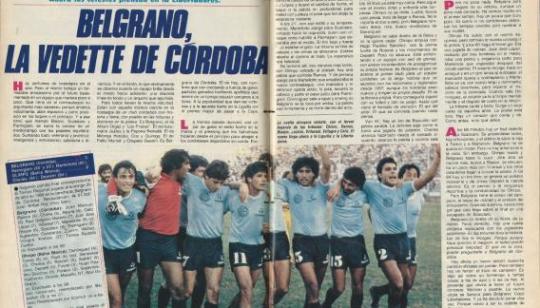
(Archivo Gustavo Farías)
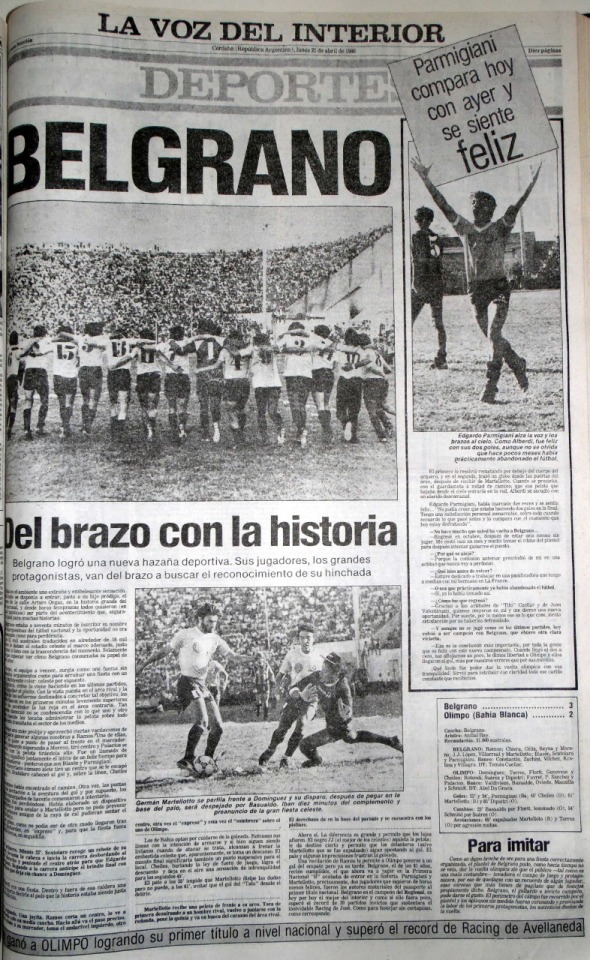
whatsapp_image_2020-04-20_at_7.10.45_pm_1587423370.jpeg
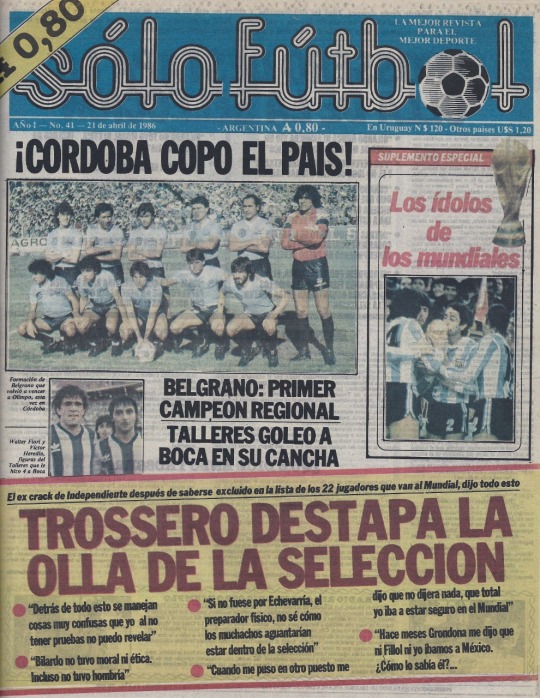
whatsapp_image_2020-04-20_at_7.10.44_pm_1_1587423379.jpeg
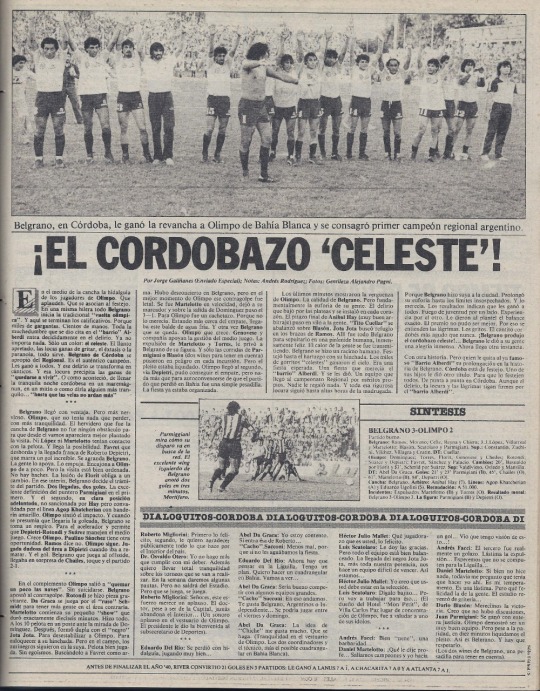
whatsapp_image_2020-04-20_at_7.10.44_pm_1587423394.jpeg

(Archivo Gustavo Farías)
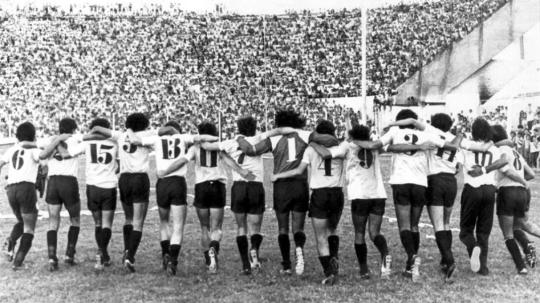
belgrano-1986_1587422623.jpg

(Archivo Gustavo Farías)

(Archivo Gustavo Farías)
source https://mundod.lavoz.com.ar/futbol/belgrano-y-un-recuerdo-unico-para-el-futbol-de-cordoba
0 notes
Photo
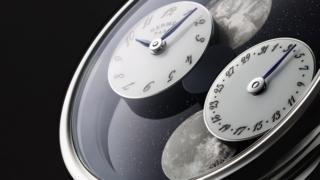
New Post has been published on https://toldnews.com/business/hermes-where-the-luxury-giant-is-an-industry-outsider/
Hermes: Where the luxury giant is an industry outsider
Image copyright Joel Von Allmen
Image caption Hermes only moved into men’s watches seven years ago. It’s new Arceau L’Heure de la Lune sells for £20,500-plus
Hermes may be a big cheese in the world of luxury goods, but in the world of Swiss watchmaking it is something of an outsider.
First, it is French. Second, it’s a relative newcomer. Third, the bulk of its watches are aimed at women in a still male-dominated industry.
Hermes is at this week’s Salon International de la Haute Horlogerie (SIHH) watch fair in Geneva, where the display cabinets are weighed down with chunky timepieces as complicated as a Ferrari car (but frequently cost more).
“We are one of the challengers to an industry that is 300 years old,” says Laurent Dordet, who heads the watch division, La Montre Hermes. He knows there’s a lot of work to do “to become legitimate and accepted”.
It helps being at this week’s annual watch event, an invitation-only affair where Switzerland’s most exclusive brands and artisan workshops unveil their latest products.
Paris-based Hermes is allowed in because it makes its watches in Switzerland. The listed, but still family-owned company, better known for its leather and silk products, got into ladies’ watches about four decades ago, and men’s in 2012.
But it is only in recent years that it became a more serious player, investing heavily to buy up Swiss component makers.
Image copyright Hermes
La Montre Hermes now produces all the dials, cases, and movements in-house – unlike some competitors. The division employs about 300 people, a fraction of the 13,000 employed in the core businesses.
Mr Dordet, a Hermes lifer, used to run the leather goods business, where his products were at the top of the luxury tree.
In the industry, Hermes’ leather watch straps were as highly regarded as the watches. It makes straps for brands such as Parmigiani, and they are also available for the Apple Watch.
Now, since his appointment in 2015, he’s running an operation where the brand must work harder to get noticed. “It’s a challenge,” Mr Dordet says.
He’s been taking La Montre Hermes up the value chain. The business used to trade in the €2000-€3000 ($2,280-$3,420; £1,770-£2,660) bracket. Pricey to most people, but not in the world of fine watches.
But having a completely in-house operation means Hermes can design and produce far more complicated pieces, not just in the looks but the mechanics inside.
Hermes’ standard watches now cost as much as €30,000, while special pieces with jewels are €100,000-plus.
Ariel Adams, founder of the closely-read website ablogtowatch.com, says female fashion house watches – where the product is just one of many luxury items – have traditionally not been taken as seriously as those produced by firms that only make timepieces.
“There has been an unfortunate bias by collectors against watch brands that appear to primarily produce products for women,” he says.
“I’ve personally never quite understood this. Perhaps it is the large assortment of comparatively inexpensive women’s fashion watches that have prevented more high-end customers from taking the watches more seriously.”
Image copyright Joel Von Allmen
Image caption Despite it’s simple design, Mr Dordet says the shape of the Galop d’Hermes made it one of the most complicated pieces to produce
Mr Dordet wants to challenge that bias. Hermes’ new products on display at SIHH are among the most complicated yet, he says. Its Galop d’Hermes woman’s watch is not round and not symmetrical (as most watches are). That in itself makes developing the movement more difficult.
It’s a watch that he hopes will be appreciated not only for its design (which perhaps is the thing most consumers only consider), but its mechanics.
Female executives
“It’s not a classic [female] watch,” Mr Dordet says, adding in marketing-speak that could only come from a luxury goods executive: “It’s a futuristic object for today’s femininity… a woman of movement, a working person, full of projects.”
What he means is that the female watch consumer is changing – less bling and sparkle, and timepieces embedded in necklaces or broaches; and more for traditional, and slightly larger, wristwatches.
Mr Dordet adds that it will be interesting to see how the industry changes as more female executives enter the business.
Image copyright G Maillot
Image caption Fabienne Lupo, one of a growing number of female executives in the industry
In 2017 Chabi Nouri became the first woman chief executive of Piaget, while Catherine Reiner’s appointment last year as boss of the 175-year-old Jaeger-LeCoultre was also a female first.
And the managing director of the Fondation de la Haute Horlogerie, which organises SIHH, is female, Fabienne Lupo.
Smartwatch threat
What of Hermes’ men’s watches, a business started only seven years ago? It could be an uphill struggle.
“When you have a stamp on your forehead that says you are mainly a female fashion brand it’s hard to convince the guys,” says Mr Dordet.
“We are winning more respect from male customers year after year. But it’s slow because we are coming into a world where well-established men’s brands have existed for decades, even centuries,” he says.
Ariel Adams is a fan, though. “What they may lack in sheer exclusivity they make up for in a practical luxury appeal.” But Hermes is entering a crowded market, he adds.
Interestingly, Hermes has looked into the possibly of putting smart tech in watches, an area perhaps more attractive to male consumers.
However, it has discounted the move, for the moment at least. “We haven’t closed the door on it, but our conclusion is that this is not the time,” Mr Dordet says.
But, just as Hermes is establishing itself as a serious watch player, does Mr Dordet think smartwatches threaten the mechanical industry?
“Absolutely not. Smartwatches are cold, functional objects,” he says.
“Fine watches are an experience, a jewel, a luxury, an emotion,” he adds. “One thing we are all sure of [at SIHH] is that people don’t buy watches any more to see what time it is.”
0 notes
Photo

Lust Worthy Recap From Our Parmigiani Event And Kalpa Hebdomadaire Anniversaire Watch Hands-On - by Ariel Adams - See what went down and get a look at this offering from Parmigiani, which features a solid-gold movement and is a limited run of just ten pieces. - For more head to aBlogtoWatch.com Pin URL: http://ift.tt/2sgfBht Source URL: http://ift.tt/2ri0PJS
0 notes
Text
Ariel Parmigiani sigue como presidente de Parque Eólico Arauco S.A.P.E.M
El Proc. Jacob Emanuel Saúl a cargo de la Inspección General de Justicia, hace saber que por Disposición Nº 36/24 de fecha 14/03/2024 de la Inspección General de Justicia, en Expte. Nº C-023-0430-8-23, caratulado: “Parque Eólico Arauco S.A.P.E.M. s/Inscripción de Directorio”, ordena la publicación por el término de un día del presente edicto en el Boletín Oficial, dando cumplimiento al Art. 10 de…

View On WordPress
0 notes
Text
“Acá no hay ninguna empresa que haya invertido”, afirmó Ariel Parmigiani
http://www.pagina12.com.arEl litio como política de Estado y el manejo provincial de los recursos “Acá no hay ninguna empresa que haya invertido”, afirmó Ariel Parmigiani respecto a la suspensión de las licencias mineras y aseguró que la medida lo que busca es inversiones serias. La Rioja hizo ley lo que a nivel nacional se viene haciendo de hecho: declarar el litio como un recurso estratégico.…

View On WordPress
0 notes
Text
Parmigiani por el litio: "Podemos mirar otros caminos por fuera de la actividad privada"
Parmigiani por el litio: “Podemos mirar otros caminos por fuera de la actividad privada”
El presidente de la empresa estatal minera Kallpa SAPEM, Ariel Parmigiani, dialogó con Diego Schurman por radio 990 sobre la reciente decisión de La Rioja sobre el litio como recurso natural estratégico. “Esta norma ya se ha aplicado en varios países, el litio es escaso en el mundo y, al ser provinciales, requieren de muchísima importancia para dichas economías, por eso es que sirve para seguir…
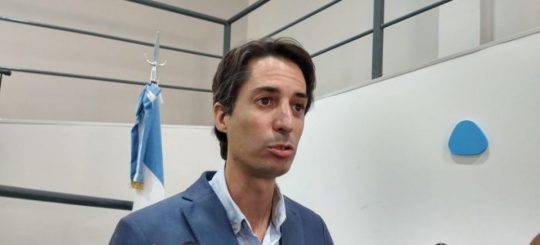
View On WordPress
0 notes
Text
El Gobierno dice que la venta del Parque permitirá construir dos nuevos, uno eólico y el otro solar: ¿Y la deuda por el Bono Verde?
El Gobierno dice que la venta del Parque permitirá construir dos nuevos, uno eólico y el otro solar: ¿Y la deuda por el Bono Verde?
El presidente del Parque Eólico Arauco, Ariel Parmigiani, indicó que la venta obedece a “una gran oportunidad dado su precio elevado, producto de un montón de circunstancias dadas en Argentina y el gran trabajo que se viene realizando en la empresa”. “Esto nos permitirá construir dos parques nuevos, uno eólico y el otro solar, que generaran más energía y recursos para La Rioja que será la única…

View On WordPress
0 notes
Text
Quintela y Royón se reunieron para avanzar en la obra del Gasoducto Productivo II y parques eólicos
Quintela y Royón se reunieron para avanzar en la obra del Gasoducto Productivo II y parques eólicos
El gobernador de La Rioja, Ricardo Quintela, y la secretaria de Energía, Flavia Royón, se reunieron hoy en Buenos Aires para avanzar en el análisis de distintas obras, como la continuidad de la obra del Gasoducto Productivo II y la construcción de dos nuevos parques eólicos en la provincia. Luego de la reunión, el presidente de la empresa riojana Parque Eólico Arauco, Ariel Parmigiani dijo que…

View On WordPress
0 notes
Text
La Rioja apunta al hidrógeno verde tras ser el primer generador de energía eólica del Norte y Cuyo
La Rioja apunta al hidrógeno verde tras ser el primer generador de energía eólica del Norte y Cuyo
La provincia de La Rioja apunta al desarrollo futuro de proyectos de producción de hidrógeno verde tras ser el primer generador de energía eólica en las regiones del Norte y Cuyo, aseguró hoy el presidente del Parque Eólico Arauco, Ariel Parmigiani. La semana pasada, Parmigiani participó en una jornada sobre “Hidrógeno Limpio y Transición Energética” en la Oficina Científica de Asesoramiento…

View On WordPress
0 notes
Text
Hands-On Debut: Parmigiani Tonda GT Steel Watch With Integrated Bracelet
Entirely new for 2020 is the Parmigiani Tonda GT and Tondagraph GT, two of the brand’s most casual and everyday wearable pieces to date. These leisure watches (a term I find increasingly appropriate) also debut a new integrated bracelet by Parmigiani, as well as a rubber strap option. I got to go hands-on with the black dial Tonda GT in steel here, but it is also available in gold with a blue dial. There are two inaugural models in the collection, the time and date Tonda GT and the steel Tondagraph GT with annual calendar and chronograph. The Tonda GT in steel will be limited to 250 pieces, the Tonda GT in gold will be limited to 150 pieces, and the Tondagraph GT will only be available in steel and limited to 200 pieces.
I will have a longer hands-on article about the Tondagraph GT very soon this week, so this article is going to focus on the Tonda GT. Briefly, the Tondagraph GT offers an impressive annual calendar/chronograph complication housed in a new 42mm-wide/13.7mm-thick case with a 100M water resistance. The orange touches on the Tondagraph GT seem to throw a welcome splash of color to the dial, which has the same guilloché “clou triangulaire” pattern. What’s most intriguing about the Tondagraph GT is the $19,500 price for an annual calendar/chronograph, and I’ll give my full hands-on impressions of it very soon. (Price is $19,500 on the integrated bracelet, rubber strap is $18,500).
So far, the sportiest Parmigiani has really gotten is the Tonda Metrographe, which is a piece I reviewed a few years back. The Tonda GT takes things further, introducing an all-new integrated bracelet (though this is not their first) and case that was designed with the help of Dino Modolo, who has previously worked with Bedat & Co., Corum, and others.
The Tonda GT case is inspired by the Tonda Chronor, though there are adjustments to the lugs, which retain that teardrop shape while allowing for the new integrated bracelet. First off, it’s so comfortable on the wrist, with the links cascading naturally from Michel Parmigiani’s recognizable teardrop lugs. The center links alternate between larger polished and smaller brushed segments, while the end-links are impressively finished with both brushing and polishing. The double-folding clasp is nice and secure, rounding out a very well done bracelet that shines as a piece of “functional jewelry” in the words of aBlogtoWatch founder Ariel Adams.
While pointing out steel luxury sports watches with integrated bracelets has become a bit of a tired trope, at this point, it should be noted that this isn’t Parmigiani’s first. The aforementioned Metrographe had an integrated steel and titanium bracelet, though the flair of its “lobster” styling may have been a bit too much for some. The Nautilus and Royal Oak bracelets are admittedly impressive and, perhaps more importantly, influential. That said, having worn and spent time with pieces like the A. Lange & Söhne Odysseus, H. Moser & Cie Streamliner, and this Parmigiani Tonda GT, it’s clear that the big names have nothing close to a monopoly on top-tier bracelets.
Still, one does not simply integrate a bracelet and deem it a success. A truly successful bracelet must exceed the sum of individual parts and enhance the watch as a whole. Parmigiani largely succeeds here in creating a bracelet with a seamless sense of continuity with the case, such that it verges on symbiosis. Yes, it’s a bit elaborate, but this is Parmigiani we are talking about. They are not interested in the minimalist route, and the Tonda GT bracelet is all Parmigiani. What would I change? Honestly, not a lot. As nice as the double-folding clasp is, I do think Lange’s Odysseus picked relatively low-hanging fruit by offering a precision adjustment mechanism that allows for up to 7mm of size adjustment without having to take the watch off the wrist. I’d love to see some version of this function in future bracelets from Parmigiani.
The Parmigiani Tonda GT is also available on a rubber bracelet, which is very supple and super-comfortable. It has thoughtful design touches that add to the cohesion of the entire piece, like stripes that track from the lugs and a guilloché pattern that matches the dial of the watch. The rubber strap is a nice option, though it’s hard to recommend it in comparison to the bracelet. Personally, I think Parmigiani should do what some brands like Vacheron Constantin does with the Overseas and simply provide the bracelet and straps with every watch rather than having an option to choose.
The Tonda GT case measures 42mm-wide, 11.2mm-thick, with a lug-to-lug height of 46.5mm. Importantly, the Tonda GT and Tondagraph GT are water-resistant to 100M, which is an important metric for the whole identity of this piece as a sportier Parmigiani. I’d classify the Tonda GT as more of a leisure watch than a sports watch, but no matter the nomenclature I am glad Parmigiani paid attention to water resistance, as I recall the Metrographe had something like 30M.
The stepped bezel is interesting, as it is fluted on the outer ring and then is smooth as it slopes upward towards the crystal. The fluting is a nod to Parmigiani’s Toric collection, which boasts far more elaborately decorative knurling on the bezels, which is both too costly for a watch at the price point of the Tonda GT as well as too formal.
The fluted bezel and teardrop lugs firmly plant the Tonda GT’s feet in the ground as a Parmigiani watch, love it or leave it. These decorative and stylized facets of the case wouldn’t be at home in most ordinary sports watches, but I think luxury leisure watches are only made better with flair and identity (again, see the Odysseus).
The steel Tonda GT has a black dial while the gold models are done in blue with matching 18k gold hands/indices, however, all the dials have a guilloché “clou triangulaire” pattern. There is the big-date indicator at 12 o’clock and a double-track running seconds sub-dial at 6 o’clock, both of which are Parmigiani design touches directly carried over from the Tonda Chronor. The skeletonized Delta-shaped hands are quite polished but are legible enough (though another application of AR coating would not hurt here). There is, however, lume on the very tip of the hour and minutes hands, as well as on the rhodium-plated hour indices.
The Tonda GT is outfitted with the PF044 movement, a new automatic caliber made of 274 components and 33 jewels. The movement operates at 28,800 vph and has a 45-hour power reserve. There are Geneva stripes throughout the movement, but the 22k-gold rotor is where the eye is drawn when looking at the PF044. It’s a really well-finished and impressive-looking movement, all things considered. Of course, it’s not what Parmigiani offers at the higher end of the spectrum, but it is still very nice for this price point.
The Tonda GT is a fun new offering from Parmigiani that still retains Michel Parmigiani’s design DNA while rethinking some facets in order to create a truly wearable leisure watch. It’s got flair but isn’t formal or dressy, and the water resistance will go a long way for many buyers. The Parmigiani Tonda GT in steel seen here is limited to 250 pieces and priced at $13,500 on rubber strap and $14,500 on steel bracelet. The Tonda GT in gold is limited to 150 pieces and priced at $24,900 on rubber strap and $49,500 on gold bracelet. You can learn more about the Tonda GT here at parmigianiamericas.com.
The post Hands-On Debut: Parmigiani Tonda GT Steel Watch With Integrated Bracelet appeared first on Wristwatch Journal.
from WordPress https://ift.tt/38BIJWJ via IFTTT
0 notes